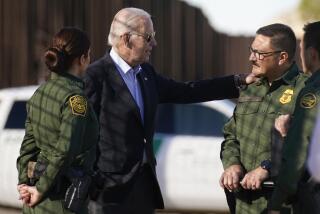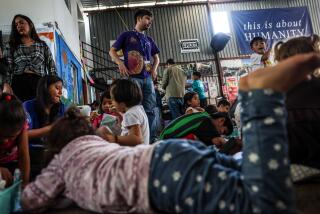White House expected to give U.S. troops permission to use force to protect Border Patrol

Reporting from Washington — The Trump administration plans to grant U.S. troops on the Mexican border the authority to use force to help protect Border Patrol officers, defense officials said Tuesday, a significant widening of a mission already criticized as politically motivated rather than a national security priority.
President Trump is expected a sign an executive order giving armed troops the authority to intervene if U.S. personnel are endangered by migrants trying to cross the border, the officials said. The order doesn’t rule out use of deadly force.
The order could face legal challenges to determine if it violates a U.S. law that bars active duty military from conducting domestic law enforcement functions. The Posse Comitatus Act, first passed in 1878 and amended several times, is intended to limit the government’s ability to use military personnel within the United States except in natural disasters, terrorist attacks and other national emergencies.
Roughly 5,900 active duty soldiers and Marines were sent to border posts in California, Texas and Arizona shortly before the Nov. 6 election in one of the largest such deployments in decades. Most of the troops are unarmed and restricted from interacting with migrants, and critics — including some former senior military officers — condemned the operation as using active duty troops for partisan gain.
Trump’s expected expansion of their role is likely to deepen questions into whether he is trampling longstanding practices on the legal use of the military on U.S. soil, and raises the risk that a confrontation with unarmed migrants could escalate into deadly violence.
It also could lengthen the time at least some of those troops must spend away from home. Commanders previously have said they plan to withdraw all troops by Dec. 15 unless an extension is ordered. After news reports suggested that some troops could be withdrawn this week, the Pentagon pushed back and said some may be transferred to other border posts.
“We are continually assessing our resources and refining requirements,” the Army command based in San Antonio, Texas, that is overseeing the operation said in a statement Tuesday. “We may shift some forces … to engineering support missions in California and other areas. No specific timeline for redeployment has been determined.”
The deployment will cost about $72 million through Dec. 15, but the final cost “has yet to be determined and will depend on the total size, duration and scope” of the operation, according to Col. Rob Manning, a Pentagon spokesman.
So far, the troops on the border have been authorized only to protect other military personnel. Expanding that authority to help protect Border Patrol agents, who are also armed, would likely involve military police units, officials said.
Trump suggested last month that the military might open fire on anyone who threw rocks at them on the border, a statement he later amended, saying migrants who threw rocks would be arrested and prosecuted, not shot. The Border Patrol has long faced criticism that officers have used excessive force, including killing unarmed individuals.
Democrats stepped up their criticism of the deployment Tuesday, accusing Trump of deploying the military unnecessarily for partisan gain before the election by exaggerating the threat from caravans of Central American migrants. Several thousand people have arrived in Tijuana, near the the San Ysidro border crossing, but more are en route and are expected to seek asylum.
“It was not a respectful use of our military to take service members away from their duties and send them to the border as politicized props, and President Trump should not have done it,” said Rep. Adam Smith (D-Wash.), who is likely to take over as chairman of the House Armed Services Committee in January. “They should all be returned to their regular duties.”
Trump ordered the deployment — at one point he said it could grow to 15,000 troops — to block what he repeatedly warned was a looming “invasion” of criminals, gang members and terrorists moving north through Mexico. By all accounts, the bulk of those on the move are families fleeing violence in Central America.
The president has barely mentioned the supposed threat since the election, but the White House scrambled after it took flak on Monday when news reports suggested the Pentagon might withdraw some troops this week that have largely finished installing razor wire and building obstacles at border crossing points. The expected executive order was first reported by CNN.
Under longstanding Pentagon rules, any military response to possible violence by migrants must be proportional to the perceived threat. Officials refused to disclose specific guidelines being considered for changing those rules, and declined to speak on the record, citing Pentagon regulations.
“We would not treat a mob of unarmed migrants in the same way as we would treat armed combatants,” the official said. “I would expect them to follow the standard rules.”
Border Patrol agents are armed and have authority to protect themselves. But the Department of Homeland Security, which includes Customs and Border Protection, the parent agency of the Border Patrol, asked the Pentagon for help protecting its personnel before Trump sent troops to the border in late October.
The Pentagon rejected the request over concerns that Trump’s initial deployment order did not give troops the legal power to use force in assisting law enforcement within the United States, officials said. Trump signed that order in April when he dispatched 2,100 National Guard troops to the border.
Homeland Security officials, however, continued to press for the military to be authorized to use force. As long as Trump signs the executive order, the Pentagon no longer objects to protecting Border Patrol personnel and believes it would not be violating the Posse Comitatus Act, one official said.
“As far as we’re concerned, if our forces are simply protecting others who happen to be law enforcement, it still isn’t a law enforcement role” for the military, one of the officials said.
According to a 2018 Congressional Research Service report on the statute, the Posse Comitatus Act allows use of military force to prevent loss of life and to protect federal government functions, exceptions that Pentagon lawyers may invoke to justify use of troops to protect Border Patrol agents.
But confrontations involving armed troops sent to the border to assist law enforcement have led to deaths in the past. In 1997, an 18-year-old American was killed by a Marine near the U.S. border, an incident that led to a temporary suspension of troop patrols there.
Pentagon officials previously have said the current deployment is only authorized until Dec. 15 unless the Department of Homeland Security requests an extension. A drawdown in the next few weeks could mean they would leave the border before some of the migrant caravans have arrived.
The first troops to be withdrawn are likely to be engineering units that have largely finished beefing up defenses at border crossing points. The Pentagon also sent military logistics, helicopter units and a small number of infantry, public affairs and other types of military specialists.
Three Democratic lawmakers wrote Tuesday to Defense Secretary James N. Mattis criticizing the border deployment and signaling that they intend to investigate the White House move when Democrats take control of the House in January.
Sen. Elizabeth Warren (D-Mass.), Rep. Jackie Speier (D-Hillsborough) and Beto O’Rourke (D-Texas), said they were “increasingly concerned about the lack of planning for and continued lack of clarity surrounding this operation, the lack of a clear mission for the deployed troops, the cost of this operation, and the appearance that the president is using the military for partisan political purposes.”
Among other questions, they asked Mattis to provide details about troops’ use of force rules on the border, alluding to Trump’s comment about shooting rock-throwing protestors.
Reports of a possible attempt by some to rush illegally through the San Ysidro Port of Entry prompted the temporary suspension of operations there early Monday, but officials said later it was a false alarm.
Twitter: @davidcloudLAT
More to Read
Sign up for Essential California
The most important California stories and recommendations in your inbox every morning.
You may occasionally receive promotional content from the Los Angeles Times.











